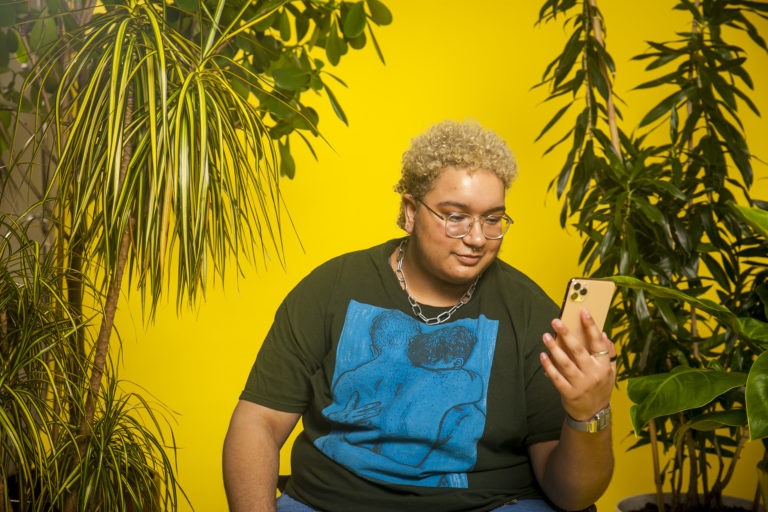Acne is a skin concern that affects many of us. For trans and nonbinary folks on gender-affirming hormone therapy (GAHT), or HRT, acne is a common side effect and can present unique and frustrating challenges. It’s important to understand that acne isn’t just a cosmetic concern—it’s a clinical skin condition that deserves attention and effective management. From the clinical perspective, acne encompasses a range of blemishes, including pimples, blackheads, and whiteheads, all stemming from clogged pores and inflammation. As hormone levels shift during GAHT, the skin’s oil production can increase, leading to acne breakouts that can vary in severity.
While this can be a frustrating experience, there is effective and affordable treatment available! Treatment—such as topical meds or oral medication—can improve acne on your face and/or body. Best of all, it doesn’t interfere with gender-affirming hormone therapy!
Table of Contents
Does HRT Cause Acne?
Hormone changes experienced by adults on GAHT can trigger a “second puberty” and cause similar effects as puberty one would experience during adolescence, including acne. Acne on HRT can occur during second puberty for a few reasons:
- Hormonal changes: The introduction of estrogen or testosterone can lead to increased oil production in the skin, which can clog pores and lead to acne breakouts.
- Skin sensitivity: Hormonal fluctuations can also make the skin more sensitive, making it more prone to inflammation and acne.
- Hair growth: For trans and non-binary people taking testosterone, increased hair growth can sometimes lead to ingrown hairs, which can become inflamed and resemble acne.
A few things go into making a pimple. Oil and bits of dead skin clog your pores. When these clogged pores become inflamed, a pimple forms. Skin bacteria can worsen acne by adding to inflammation. Oil, dead skin, and bacteria are all natural and common, but GAHT can cause your body to make more oil. This can make acne worse.
It’s important to note that while acne can be a common side effect of hormone therapy, it’s not a guarantee for everyone. Additionally, the severity of acne can vary widely from person to person. Some may experience mild breakouts, while others may have more severe acne requiring medical treatment.

Available treatments
The primary goal of acne treatment is to reduce oil and inflammation. Sometimes, we also have to fight bacteria. However, the bacteria involved in acne become easily resistant to antibiotics, so antibiotics are not a long-term solution. Frequently, we use two or more medications at a time to attack those pimples.
A visible improvement in acne can take 2-3 months. You may notice fewer pimples during this time. Initial treatment will likely improve acne but may not clear it completely. Patients often need to use some acne treatment long-term; it is not usually a total cure. If acne has caused dark spots on your skin, these can take much longer to go away. Common medications used for mild to moderate acne include:
Tretinoin
Tretinoin (“Tret-i-no-in”), a form of vitamin A and a type of topical retinoid, is part of most acne treatment regimens. Applied topically, it helps to keep pores clear and reduce inflammation.
- Common side effects:
- Tretinoin can cause redness and irritation of the skin. It often helps to start by using it every other day. As your skin gets used to it, you can slowly increase your application daily. It also helps to wait at least 20 min after washing your face before applying it to ensure your skin is completely dry.
- Tretinoin can make your skin more sensitive to the sun. It’s best to apply it at night and wear sunscreen daily.
Benzoyl peroxide
Benzoyl (“Benz-oil”) peroxide comes in many forms, such as a gel, cream, or body wash. Lower-strength formulas between 2% and 10% can be purchased without a prescription and used alone or with other medications. Benzoyl Peroxide works by removing dead skin and bacteria and reducing inflammation.
- Common side effects:
- Benzoyl Peroxide can cause skin redness and irritation. It can also bleach towels and clothing. We recommend starting slow and not getting it near your favorite clothes or towels!
Azelaic acid
Azelaic (“uh-zeel-ik”) acid is applied to the skin and works by attacking the bacteria that cause acne. It can be used alone or with other meds. Common side effects:
- Azelaic acid can cause redness and irritation of the skin.
Salicylic acid
Salicylic (“suh-luh-sil-ik”) acid can be found over the counter without a prescription. It is used in body/face washes and creams to unclog pores by removing oils and dead skin. It can be used alone for mild acne or with other medications.
- Common side effects:
- Salicylic acid can cause redness, dryness, and irritation of the skin.
Topical antibiotics
Topical antibiotics are prescription antibiotics applied directly to the skin as a gel or topical solution/cream. They work by attacking acne-causing bacteria. These should not be used alone but in combination with other acne medications. Formulations are available that contain both topical antibiotics and other topical acne medications.
- Common side effects:
- Topical antibiotics can cause redness and irritation of the skin.
Oral Antibiotics
Oral antibiotics are prescription tablets or capsules taken by mouth, usually once or twice a day. They work by attacking the acne-causing bacteria. These are designed for short-term use only to get bacteria under control.
- Common side effects:
- Oral antibiotics can cause gastrointestinal (GI) upset, nausea, vomiting, and diarrhea.
- Certain antibiotics, like doxycycline and minocycline, can make you sunburn more easily.
Oral Contraceptives (OCPs)
Oral contraceptives are estrogen and progestin-containing prescription pills that you take by mouth once a day. They work by helping to reduce the amount of circulating “male” sex hormones, which can cause acne. OCPs do not interfere with T and can be taken safely with T therapy, but some patients on T do not want to add estradiol to their bodies. This is a personal choice!
- Common side effects:
- OCPs can cause nausea, breast/chest tenderness, irregular bleeding, and headaches.
NOTE: Sometimes, acne can become so bad that it leads to scarring. For more severe acne, we recommend seeing a dermatologist. Plume does NOT prescribe isotretinoin (Accutane).
Skincare tips while taking GAHT
Developing a new skincare routine is a great way to manage the acne you may develop. Here are a few tips to get you started.
- Don’t touch, squeeze, or pick at a pimple.
- Wash your face with gentle cleansers. Look for cleansers containing salicylic acid and benzoyl peroxide.
- Select “non-comedogenic” skin products and moisturizers.
- Avoid scrubbing or exfoliating your skin.
- Use a daily sunscreen of SPF 30 or higher. Many acne medications can cause increased sun sensitivity.
Starting treatment with Plume
Acne treatment is available through Plume! Treatment—such as topical meds or oral medication—can improve acne on your face and/or body. Best of all, it doesn’t interfere with gender-affirming hormone therapy (GAHT)!
If you’re struggling with acne while undergoing GAHT, we offer accessible and personalized care. Through video visits with our specialized medical providers, we can assess your skin and tailor a treatment plan to your needs. During this visit, your provider will ask questions about your acne and any previous treatments you’ve tried. We’ll help you decide on a skin care plan based on your skin type, where your acne is, and how severe your acne is. Depending on your assessment results, we may prescribe one or more medications for you. By addressing the various causes of your acne, we can give your skin the best chance to stay clear and healthy! Our goal is to support you on your gender journey, and that includes working towards clearer and healthier skin. Schedule a video visit with Plume today and take the first step!



